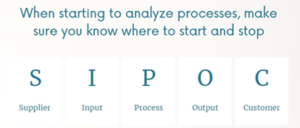Process improvement
The primary goal in process improvement is to increase the efficiency of your team or organisation. To achieve this, it is crucial to understand your processes well. SIPOC and the turtle diagram are powerful tools to effectively delineate your processes, preparing the way for further analysis and continuous improvement. In this blog, I will explain more about the SIPOC and turtle diagram methodology so you can use it as a first step for process analysis.

SIPOC
SIPOC provides an overview of key components to delineate a process. These components of SIPOC are clarified below.
- Supplier: Identify the sources or individuals that provide input to the process. These can be departments, external suppliers or systems. It is about those who provide input to get the process started, so this may as well be the customer! Take, for example, the customer who is submitting an online order. In this case, the customer is the “supplier” following the SIPOC method.
- Input: Define the raw materials, information or resources needed for the process. These inputs are the basis of your process and must be effectively monitored and controlled during the process. In our example, the order, specifically, the order form and order data are the input to the process.
- Process: Outline the set of steps or activities to be performed to transform the input into output. When delineating the process using SIPOC, you don’t need to go into detail yet. Feel free to do this at a later stage. However, you should at least give the process a proper name here. In our example, it is “Placing an order using the website”.
- Output: Define the deliverables or outcomes of the process. This is a tangible product, service or can also be another outcome such as a report or decision. In our example, we can refer to the output as “received the product or service ordered”.
- Customers: Identify the individuals, departments or stakeholders who receive the output of the process. Understanding customers’ needs and expectations is vital for process improvement. So, identify clearly who is the consumer of the output of this process. For our example, we can label our website visitors as the customer of the process.
By using SIPOC for your process analysis, you make it clear to the other stakeholders where the boundaries of the process you want to improve lie. So, you speak the same language before you start analysing. This prevents misunderstandings afterwards. As a result, you quickly see interdependencies and get a better grip on the components.
Delineate your process before analysing!
Turtle Diagram
The turtle diagram methodology gives you a more detailed process delineation, A turtle diagram lists the key things that are important to the process but -like SIPOC- does not show who performs which process steps when.

The Turtle Diagram allows you to dive into the details of a process, facilitating in-depth analysis and providing valuable insights for improvement.
Gain comprehensive insight into your processes.
In the journey towards process improvement, effectively defining your processes is a crucial first step. The SIPOC and Turtle Diagram Methodologies provide valuable information to gain a comprehensive understanding of your processes, identify areas for optimisation and achieve sustainable results. By using these methodologies, you can:
- unlock greater efficiency!
- streamline workflows!
- foster a culture where process improvement is central.
Triggered to discover our tools for optimisation?
Contact Insightful and schedule your free appointment here.